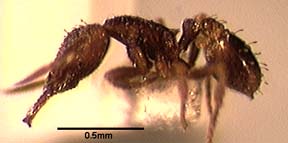Strumigenys carinithorax Borgmeier 1934
Dacetini, Myrmicinae, Formicidae, Hymenoptera, Insecta, Arthropoda, Animalia
John T. Longino, The Evergreen State College, Olympia WA 98505
USA.
longinoj@evergreen.edu
21 April 1997

Specimen: Costa Rica, Prov. Heredia: La Selva (J. Longino 3203-s). INBIOCRI001237677. Image by J. Longino.
Identification
Mandible somewhat bowed; apical fork of mandible without intercalary tooth; mandible usually with two preapical teeth or denticles, a proximal one near mandibular midlength, and a distal one about half way between proximal tooth and apical fork; proximal tooth may be greatly reduced or absent; gaster smooth with strong basal costulae; gaster with erect setae either distinctly spatulate or weakly thickened.
|

Specimen: Costa Rica, Prov. Heredia: La Selva (J. Longino 3203-s). INBIOCRI001237677. Image by J. Longino. |
Head width 0.373mm, head length 0.475, mandible length 0.272, CI 79, MI 57 (n=1 specimen from La Selva Biological Station, Costa Rica).
Suriname is the type locality of carinithorax. Costa Rican material is tentatively placed here, because it matches Brown's (1959) description fairly well.
Range
Suriname, Costa Rica (Atlantic and southern Pacific lowlands).
Natural History
Brown and Wilson (1959) summarize the genus as follows:
"Widespread in tropics and warm temperate areas. Primarily forest-dwelling; some species occur in grassland and arid scrub. ... Nests mostly in soil and rotting wood; a few species live in arboreal plant cavities in tropical rain forest. Foraging hypogaeic to epigaeic-arboreal. Food: most species are collembolan feeders; a few are polyphagous predators or occasionally feed on sugary substances..."
carinithorax occurs in lowland wet forest, in leaf litter on the forest floor.
Selected Records
Winkler and/or Berlese samples from La Selva, Braulio Carrillo National Park at 300m, Osa Peninsula (Rancho Quemado).
Literature Cited
Brown, W. L., Jr. 1959. The neotropical species of the ant genus Strumigenys Fr. Smith: Group of silvestrii Emery. Studia Entomologica 2:25-30.
Brown, W. L., Jr., Wilson, E. O. 1959. The evolution of the dacetine ants. Quarterly Review of Biology 34:278-294.
 Go back to top
Go back to top

